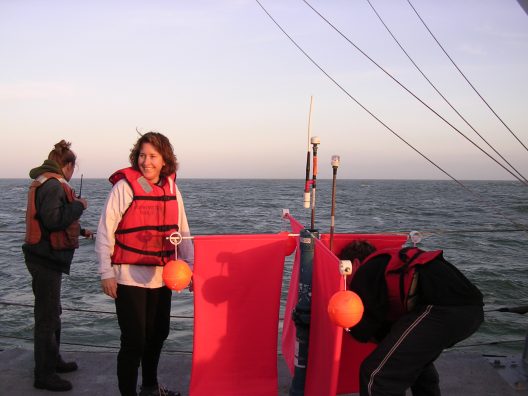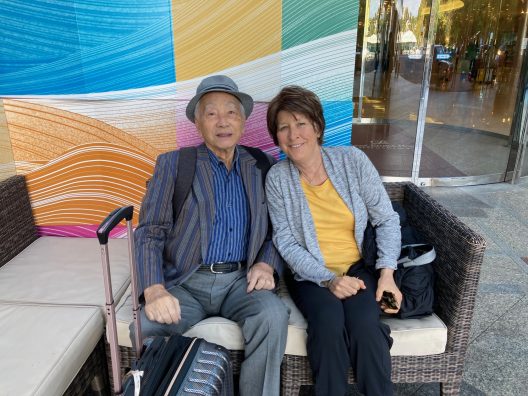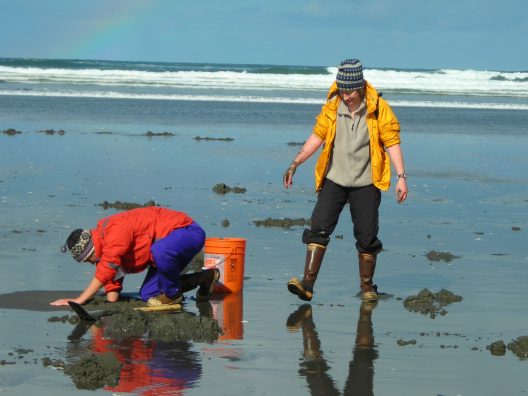Olympic Natural Resource Center’s Marine Science Director, Dr. Vera Trainer, awarded Yasumoto Lifetime Achievement Award
SEFS Research Scientist and Marine Science Director at the Olympic Natural Resource Center, Dr. Vera Trainer, has been awarded the Yasumoto Lifetime Achievement Award. Every two years, the International Society for the Study of Harmful Algae recognizes an individual with a long, outstanding record of contribution to harmful algal research. Receiving this recognition is an incredible honor established in honor of Dr. Takeshi Yasumoto, who made pioneering contributions to the identification of seafood toxins.
Dr. Trainer was recognized for the unique tools that she has brought to the field of ocean science that allow for rapid screening of marine toxins in seawater, leading to the discovery of the initiation sites for harmful algal blooms (HABs) off the U.S. west coast. This work led to a multitude of research projects that use these “natural laboratories” to study HABs. After a 30-year career with NOAA, she is now Marine Science Director of the Olympic Natural Resources Center at the University of Washington where she focuses her efforts on strengthening community partnerships across the State of Washington through leadership of the Olympic Region Harmful Algal Bloom Partnership (ORHAB).

Q&A with Dr. Vera Trainer
How did you find your way into this type of research? Any mentors or people that you’d like to thank for helping you along your journey?
Dr. Vera Trainer: During my studies at the University of Miami, I heard a lecture by Dr. Karen Steidinger about Florida red tides and their impacts on tourists, fisheries and marine life. I was hooked. I wanted to learn as much as possible about these miniscule phytoplankton that can have such a huge impact on us. I’ve had amazing mentors along the way, including Dr. Steidinger, Dr. Peter Ortner and Dr. Daniel Baden who guided me through my graduate studies, Dr. William Catterall (postdoctoral studies), Dr. John Stein (NOAA) and Dr. Bernard Bormann (UW). I have learned so much from many colleagues along the way, but special mention goes to Drs. Charles Trick, William Cochlan and Mark Wells. We were once described as the “dream team” by one of the reviewers of a grant proposal which was funded to study HABs off the coast of Washington.
Can you describe some of the tools that you have developed over the years that have led to the discovery of HAB initiation sites?
VT: I used antibody-based tests, similar to CoVID tests, called enzyme-linked immunosorbent assays (ELISA) during my graduate work, but noticed that they weren’t used widely in the ocean sciences. While I was at NOAA, we developed our own antibodies and used these to make tests that allowed us to analyze over 30 samples at once on research cruises. ELISA gave us amazing capabilities to test for toxins in seawater samples while onboard the ships. We mapped the presence of toxins in HABs all along the entire U.S. west coast. We found these “hotspots” which my colleagues jokingly called “ocean crockpots,” the initiation sites for HABs in California, Oregon and Washington. This information has opened the door to understanding the origination, transport, and decay of HABs locally and around the world. Sampling and analysis has evolved to include autonomous vehicles, which we are now sending out to these hotspots to look for toxins using ELISA.

How has your work impacted communities affected by HABs here in Washington and along the western coasts?
VT: Back in the late 1990s when I started my ocean research in Washington State, collaborators would send samples to Seattle for analysis. Now each of the coastal tribes, the Makah, Quileute, Hoh and Quinault, and the WA Dept of Fish and Wildlife have coastal laboratories that are well-outfitted and allow them to do microscope analysis and toxin testing in seawater samples. The Tribes requested this training and knowledge; they are now part of an integrated network that provides real-time data. These data provide a timely early warning of HAB events that are synthesized into a Pacific Northwest HAB Bulletin. This information is shared widely with tribal and State managers that allow them to make decisions about harvest openings and closures.
How do HABs impact the everyday person right here in the Pacific Northwest? What are some of the inconspicuous ways that HABs impact local communities? Does their impact fall under the radar?
VT: If you enjoy razor clamming or other types of shellfish harvesting in Washington State, then you benefit from our monitoring of HABs that ensures that shellfish are safe to eat. It is extremely rare for anyone to get sick from toxins in shellfish in our region. That is because the Washington State Department of Health does an amazing job, and by collaborating with HAB monitoring programs, such as Olympic Region HAB (ORHAB) partnership and SoundToxins, they know when to collect additional samples for shellfish in areas of greatest HAB risk. This makes our State one of the leaders in comprehensive, cost-effective HAB monitoring. This also keeps our shellfish companies in business. The social, economic and cultural benefits of shellfishing in Washington is unparalleled and helps our community maintain its connection to nature and its bounties.
What do you think has been your single greatest lifetime contribution to HAB research?
VT: Building community. The Olympic Region HAB (ORHAB) partnership along the Washington outer coast and SoundToxins in Puget Sound are my legacy. These community members will continue to be the “eyes on the coast” long after I’m gone.
What does winning this award and being recognized for your achievements mean for your future work and research around HABs?
VT: The Yasumoto Lifetime Achievement Award is my life’s greatest honor. Professor Yasumoto, for whom the award is named, is one of the most esteemed members of the HAB community. His discovery of the structure and function of many of the HAB toxins opened the door to further understanding the ecology of these organisms. This award brings prestige not only to me, but to HAB science in the State of Washington. International scientists want to learn more about our programs and partnerships. What we do has been emulated around the world, in places like Alaska, the Philippines, Guatemala and Indonesia. It is my hope that our work will continue to be recognized worldwide, and form the cornerstone for scientific understanding and community building.

Your team has worked with local tribes to help them identify and detect toxins in clams and other shellfish. What has this collaboration meant for you, the tribes and coastal communities?
VT: I am so grateful for the many collaborators who have taught me so much. I would not have won this award without them. They have taught me how to truly listen and to understand the value of building a community of mutual respect. My knowledge was gained through the assimilation of the stories told to me by tribes and other colleagues over the years. I hope that our partnerships will continue to be recognized in the years to come.

Learn more about Dr. Trainer’s work in local and international news
Oregon Public Broadcasting | Biotoxin affects shellfish harvesting in Oregon, Washington
The Seattle Times | Toxic algae bloom may be the largest ever
Oregon Public Broadcasting | Study pins toxin algae blooms at Oregon’s southern border on climate change
New York Times | Where the Sea Ice Recedes, So Does an Alaska Way of Life